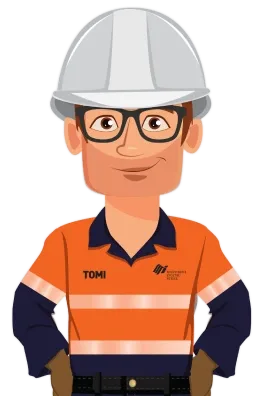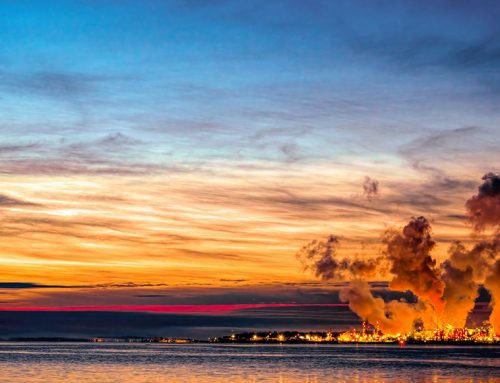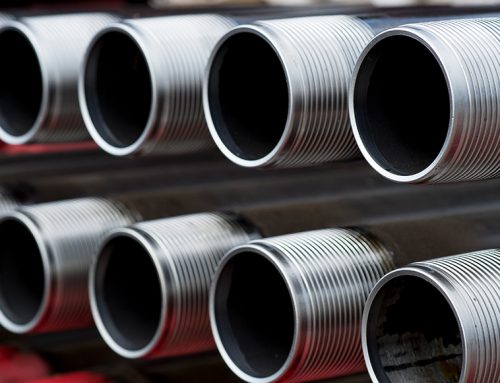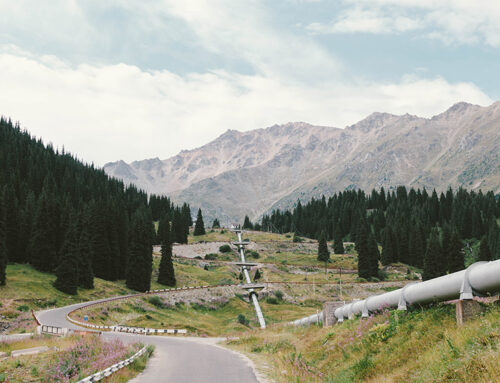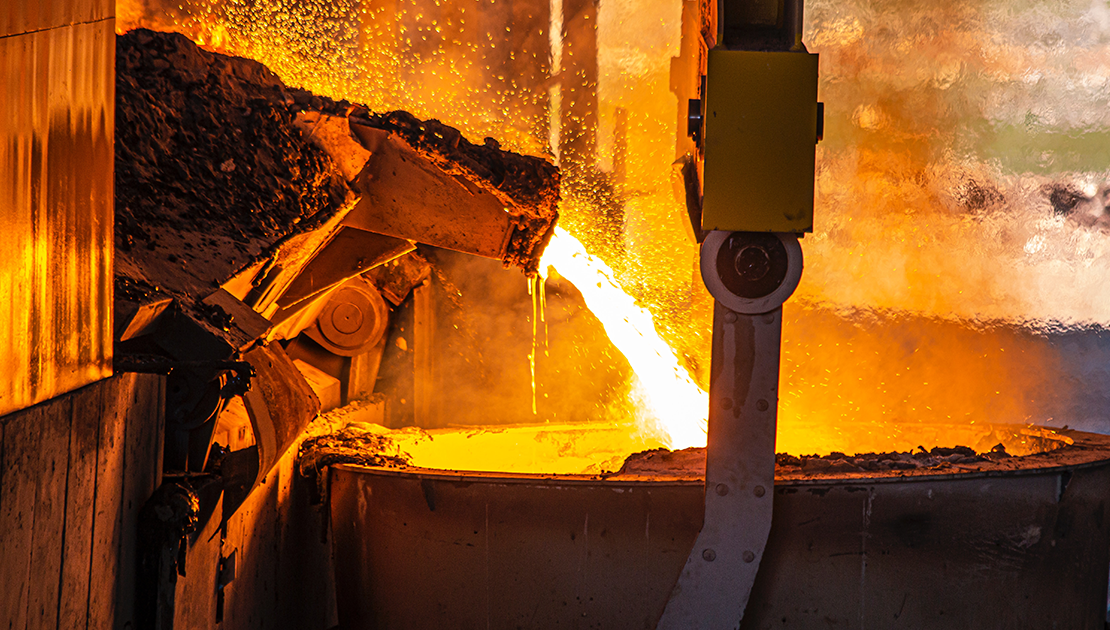
OCTG, or Oil Country Tubular Goods, is a term that refers to pipes used in the oil and gas industry for production purposes, including drill pipe, casing and tubing. OCTG is used for both onshore and offshore activities and is produced worldwide. In this guide to OCTG, we will examine the process of producing pipes, from sourcing raw materials and steelmaking to pipe rolling and finishing.
Steelmaking Process: Materials
Steelmaking begins with raw materials, such as iron ore, sponge iron, or recycled scrap steel. When starting with iron ore, there are two main methods to produce a pure iron product that can be further refined into steel through secondary refining. The first and classic method is the use of a blast furnace, while a more recent method is direct reduction. With the blast furnace, iron ore, limestone and coking coal are continuously loaded through the top of the furnace while hot air is blasted through the lower section, driving a series of chemical reactions that result in molten pig iron accumulating at the bottom. Direct reduction is a more modern process that heats the raw iron ore in the presence of natural gas or some other reducing gas to chemically strip the oxides and other impurities from the iron ore, resulting in a porous 90% pure sponge iron. This sponge iron, which can be pressed into pellets for easy storage and transport, and can then be added with recycled scrap steel to an electric arc furnace to generate molten iron.
Steelmaking Process: Primary Refining
The primary refining process aims to get the steel as close as possible to the desired chemical makeup. Molten iron may contain many impurities that cannot be present in final OCTG products. Therefore, refinement in primary furnaces is required to get closer to the desired chemistry and convert the molten iron to steel. The iron has a carbon content greater than 4% at this stage. To generate steel, it must be reduced below 1.5%, which is achieved through one of the following two processes:
1. Basic Oxygen Furnace
This method is used to transform carbon-rich molten pig iron into steel. Oxygen is blown through the molten metal to help drive combustion and burn off carbon and other impurities in the iron to create steel. Flux agents such as limestone are added to further strip undesirable elements from the steel. These unwanted elements float to the surface as ‘slag’, which is poured off, leaving behind the pure steel.
The basic oxygen furnace is the fastest steelmaking process and allows for large batches of over 250 tonnes per hour. It accounts for the production of close to 60% of the world’s steel.
2. Electric Arc Furnace
This process typically uses sponge iron or recycled scrap steel rather than pig iron. Electric arc furnaces offer more flexibility than blast furnaces because they are able to process scrap metal, they can be more rapidly started or stopped, and they offer more variability in the production batch sizes. Once the furnace is charged with raw materials, large electrodes are lowered into the furnace and enormous amounts of electric current are passed through the material to liquefy the iron. Oxygen is also blown through the scrap to further create combustion and heat it to burn off impurities. These impurities float to the surface and are poured off, leaving pure steel.
Steelmaking Process: Secondary Refining
The goal of the secondary refining process is to reach the final desired chemistry of the steel through the addition of alloying elements, creating a homogeneous mixture through ladle refining. The process is as follows:
- Stirring – This homogeneous mix is achieved by stirring the steel with inert argon gas. The addition of alloying elements and further stirring removes unwanted elements, such as sulfur and other oxides that can lead to imperfections and reduced steel performance.
- Injecting – The addition of alloying elements and further stirring removes unwanted elements, such as sulfur and other oxides, that can lead to reduced steel performance and imperfections.
- Vacuuming – The contents of the ladle is then refined through vacuum degassing to remove any gas bubbles that could create voids or pinholes in the finished product.
- Continuous Casting – Once the steel has achieved the desired chemical properties in the ladle, it is cast into billets using the continuous casting process. To execute this process, the ladle is poured into a tundish (or ‘bowl’) with several holes in the bottom, through which the molten steel flows at a controlled speed. As it flows through the holes, the outer surface cools and hardens the steel into the desired shape, allowing the material to be turned horizontally. At just the right moment, when the steel has solidified throughout, it is cut into a billet and left to cool and marked with a heat number to maintain traceability. The billet is then stored until it is ready for processing.
OCTG Manufacturing
There are two manufacturing processes that can be used depending on the form of the input steel. They are as follows:
1. Seamless
When creating a pipe using billets, the process begins by placing a billet in a rotary hearth furnace for 2-4 hours to heat it from its cold storage state until it reaches its rolling temperature. Billets are loaded into the furnace at intervals and passed through different heating zones of higher and lower temperatures to ensure uniform heating throughout the solid billet.
Once the billet has reached roughly 1800℉/982 degree celsius, it is ready for piercing and rolling. To do this, the hot billet is squeezed between two rollers and forced over a mandrel or plug to create a hollow. This hollow is sized through various methods like elongating and stretch reduction until the desired outside diameter and wall thickness are achieved.
2. Electric Resistance Welding (ERW)
Another process used to generate OCTG tubing and casing is ERW. This process differs from seamless manufacturing in that it begins with coils instead of billets and, unlike traditional welding, does not use any additional metals to join the edges. Coils start from flats of steel that have been continually cast, like billets, and then progressively flattened to produce a long, uniform sheet that can be coiled for transportation and storage. The width of the coil from the steel mill is often much wider than the intended pipe size, so the coil is slit into narrower coils specific to the desired pipe diameter.
From there, the material is uncoiled, flattened, and has its edges trimmed. It then goes through a series of rollers that gradually roll and form the material into a cylindrical tube shape. Once the shape is obtained, a high-frequency current is passed through the edges to heat the seam, which is then pushed together to form the weld. The seam is trimmed to remove excess outside diameter and inside diameter material (also called ‘scarfing’) along the weld seam and inspected through ultrasonic testing to ensure no defects or impurities.
After the weld inspection, the weld seam undergoes an annealing (or ‘heating’) process to normalise the weld and the area around it to achieve the same grain structure and mechanical properties as the rest of the pipe. Once cooled from annealing, the pipe undergoes final sizing to reduce outside diameter if necessary and is then cut into prescribed range lengths depending on customer requirements.
OCTG Finishing
Once the pipes have been manufactured, they undergo a number of finishing processes to prepare them for outgoing use, including:
- Cutting – Pipes are cut to their final length and beveled to help start threading.
- Upsetting – If required, pipes are upset to increase wall thickness at their ends, after which they are sent for heat treatment.
- Threading – Pipes are threaded and inspected according to the inspection plan.
- Coupling Make up – Coupling make up is controlled by torque parameters.
- Drifting – Pipe internal diameter is checked after coupling assembly with a mandrel.
- Hydrostatic Testing – Pipes are filled with fluid and pressurised to verify mechanical integrity.
- Measure, Weigh & Stencil – Pipes are marked for tracking and full compliance with API & PO requirements. Learn more about OCTG industry standards here.
- Coating – The application of a coating to the outside of the pipe protects from surface corrosion during transport.
- Bundling – If required pipes are packaged, ready to be dispatched to the customer.
Are you in need of readily available OCTG products to meet your just-in-time supply needs?
Explore our international marketplace at Pipesales today.
